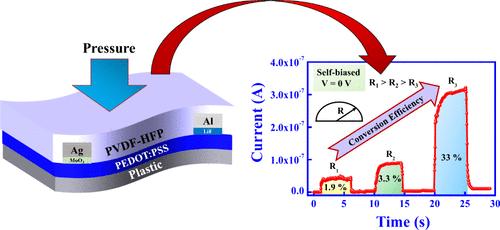用于机械能量收集装置的压势门控自偏导聚合物基柔性晶体管
IF 8.2
2区 材料科学
Q1 MATERIALS SCIENCE, MULTIDISCIPLINARY
引用次数: 0
摘要
采用聚(3,4 -乙烯二氧噻吩)-聚苯乙烯磺酸盐(PEDOT: PSS)作为导电通道,制备了一种自偏置薄膜晶体管(TFT),作为一种高效的机械能收集装置。这种顶门控TFT的自偏置是通过在器件结构内集成两个电压源来实现的,这对其工作至关重要。LiF/Al和MoO3/Ag电极分别作为TFT的源极和漏极,其工作函数差为~−1.16 eV,作为漏极偏置(VD)。作为栅极电介质的聚偏氟乙烯-共六氟丙烯(PVDF-HFP)薄膜由于施加外部压力而产生压电势,并作为该TFT的栅极偏压(VG)工作。该装置的独特之处在于其在施加机械力的过程中以直流形式长时间发电,使我们能够准确地测量其机-电转换能量。硬基和柔性基(平面)tft的功率转换效率分别为0.4和1.9%。有趣的是,柔性TFT的转换效率随着弯曲而增加,可以达到33%,这对于机械能量收集装置来说是非常高的。此外,这些器件的电气特性显示出类似晶体管的行为,在硬衬底上,开关比和亚阈值摆幅分别为2 × 102和5.88 N/ 10年,而在柔性衬底上,这些值分别为1 × 104和1.35 N/ 10年。本文章由计算机程序翻译,如有差异,请以英文原文为准。

Piezopotential Gated Self-Biased Conducting Polymer-Based Flexible Transistor for Mechanical Energy Harvesting Device
A self-biased thin-film transistor (TFT) has been fabricated by using poly(3, 4-ethylenedioxythiophene)-poly(styrenesulfonate) (PEDOT: PSS) as a conducting channel that works as an efficient mechanical energy harvesting device. The self-biasing of this top-gated TFT has been accomplished through the integration of two voltage sources within the device structure, which are essential for its operation. The LiF/Al and MoO3/Ag electrodes serve as the source and drain, respectively, of this TFT that has a work-function difference of ∼−1.16 eV, which works as the drain bias (VD). The poly(vinylidene fluoride-co-hexafluoropropylene) (PVDF-HFP) thin film that has been employed as a gate dielectric generates a piezo-potential due to the application of external pressure and works as gate bias (VG) of this TFT. The unique feature of this device is its prolonged electrical power generation in DC form during the application of mechanical force that enables us to measure its mechanical-to-electrical power conversion energy accurately. The extracted power conversion efficiencies of hard and flexible (flat) substrate-based TFTs are 0.4 and 1.9%, respectively. Interestingly, the conversion efficiency of a flexible TFT increases with bending and can reach up to 33% which is unusually high for a mechanical energy harvesting device. In addition, electrical characterization of these devices shows transistor-like behavior with an On–Off ratio and subthreshold swing of 2 × 102 and 5.88 N/decade, respectively, for hard substrate, while on a flexible substrate, these values are 1 × 104 and 1.35 N/decade, respectively.
求助全文
通过发布文献求助,成功后即可免费获取论文全文。
去求助
来源期刊

ACS Applied Materials & Interfaces
工程技术-材料科学:综合
CiteScore
16.00
自引率
6.30%
发文量
4978
审稿时长
1.8 months
期刊介绍:
ACS Applied Materials & Interfaces is a leading interdisciplinary journal that brings together chemists, engineers, physicists, and biologists to explore the development and utilization of newly-discovered materials and interfacial processes for specific applications. Our journal has experienced remarkable growth since its establishment in 2009, both in terms of the number of articles published and the impact of the research showcased. We are proud to foster a truly global community, with the majority of published articles originating from outside the United States, reflecting the rapid growth of applied research worldwide.
 求助内容:
求助内容: 应助结果提醒方式:
应助结果提醒方式:


